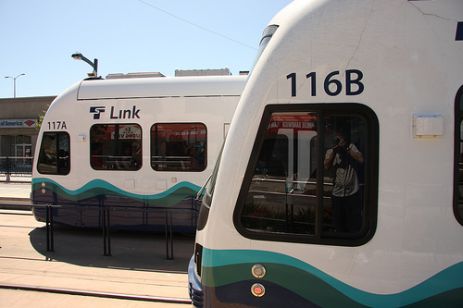 Seattle light rail. Photo courtesy LeeLeFever via Flickr One train, two views:
Seattle light rail. Photo courtesy LeeLeFever via Flickr One train, two views:
Getting to the airport from Seattle’s north side — its wealthier, whiter half — on public transit first involves a bus ride downtown. From there, as of two months ago, you can take a new light-rail line, instead of another bus, to Sea-Tac Airport. This north-side resident found the light rail underwhelming — the train chugs along at street level at a modest speed, stopping 10 times, even stopping at times for traffic lights. It’s still faster to take the express bus from downtown.
So it was interesting to hear a south-side community organizer speak Wednesday about working during the light-rail planning process to get precisely the things that annoyed me. “We [told transit planners] we wanted more stops and we don’t want intersections cut off,” said Yalonda Sinde, who was speaking at the New Partners for Smart Growth conference in Seattle.
I wasn’t blind to the fact that people live along the route, or that a new transit service could be disruptive. But Sinde’s comments were a reminder that low-carbon development in cities — or anywhere — isn’t always equally beneficial to all communities.
It was a message driven home by others at the urban-planning event: the principles of Smart Growth may be climate-friendly, but they haven’t always benefitted low-income and minority neighborhoods.
“What is the difference between Smart Growth and gentrification? This is a big question,” said Deeohn Ferris, an environmental-health lawyer, consultant, and former official at the EPA and National Wildlife Federation.
She questioned the myth that revitalizing poor neighborhoods requires outside residents, outside role models, and outside businesses. This attitude fails to appreciate the social networks and entrepreneurship potential already in those places, she said.
Urban planners often look to build new developments on abandoned lots and industrial sites — but that strategy isn’t necessarily popular with locals. “For many, ‘Smart Growth’ means fancy infill from outside people,” Ferris said. “‘Infill’ is a scary word to many communities.”
The environmental and social benefits of building better cities coincide with each other much more than they conflict (I look forward to learning more about this at this week’s conference). But enthusiasts of Smart Growth/New Urbanism/happy-walkable-what-have-you design would do well to work with environmental-justice leaders like Sinde and Ferris, who have decades’ worth of knowledge about what poorly crafted development can do to neighborhoods.



